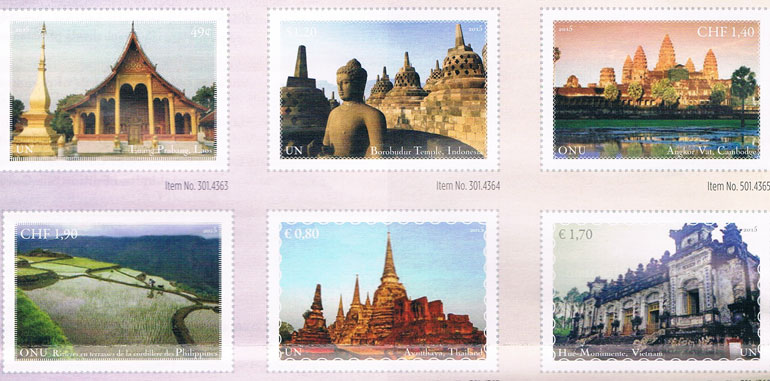Monday Dec 08, 2025
Monday Dec 08, 2025
Saturday, 23 January 2016 00:00 - - {{hitsCtrl.values.hits}}

Heritage is our legacy from the past, what we live with today, and what we pass on to future generations. Cultural heritage and natural heritage are both irreplaceable sources of life and inspiration. So states the UN Postal Administration Bulletin ‘Fascination’ in introducing the latest UN series of World Heritage stamps.
UNESCO seeks to encourage the identification, protection and preservation of cultural and natural heritage around the world.
This is embodied in an international treaty called the Convention concerning the Protection of the World Cultural and Natural Heritage, adopted by UINESCO in 1972.
Six sites in South East Asia are featured in the 2015 World Heritage series. They are from Laos, Indonesia, Cambodia, Philippines, Thailand and Viet Nam.
Luan Prabang (Laos) is an outstanding example of the combination of traditional Lao architecture and 19th and 20th century European colonial style buildings. Its unique, remarkable well-preserved townscape illustrates a key stage in the blending of these two distinct cultural traditions. Luan Prabang is exceptional for both its rich architectural and artistic heritage.
Borobudur Temple (Indonesia) is one of the greatest Buddhist monuments in the world.
It is located in the KeduValley in Central Java, Indonesia. Built during the 8th and 9th centuries AC during the reign of the Syailendra Dynasty, it is truly a masterpiece of Buddhist architecture and monumental arts.
Angkor Wat (Cambodia) in Cambodia’s Northern Province of Siem Reap is one of the most important archaeological sites in South East Asia. Stretching over some 400square kilometres, Angkor Archaeological Park contains the magnificent remains of the different capitals of the Khmer Empire from the 9th to the 15th centuries. With its impressive monuments, cultural, religious and symbolic values, the site is a unique concentration of features testifying to an exceptional civilisation.
Cordillera (Philippines) are rice terraces of the Cordillera mountain range on the island of Luzon. They are living cultural landscapes devoted to the production of one of the world’s most important staple crops – rice.
They illustrate a remarkable degree of harmony between humankind and the natural environment of great aesthetic appeal as well as demonstrating sustainable farming systems in mountainous terrain based on a careful use of natural resource.
The fruit of knowledge handed down from one generation to the next have helped to create a cultural landscape of unparalleled beauty.
Ayuthaya (Thailand) is a historic city founded in 1350 and was the second capital of the Siamese Kingdom. It flourished from the 14th to the 18th centuries when it grew to be one of the largest and most cosmopolitan urban areas and a centre of global diplomacy and commerce.
Its historic remains are characterised by the remnants of tall towers and Buddhist monasteries of monumental proportions which give an idea of the city’s past size and splendour of its architecture.
Hue Monuments (Viet Nam) located in the city of Hue in central Viet Nam was founded as the country’s capital city by Gia Long, the first emperor of the Nguyen Dynasty in 1802. It was also the cultural and religious centre until 1945. The site is known for its rich architecture and beautiful landscaping.